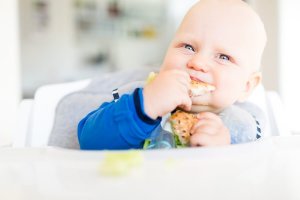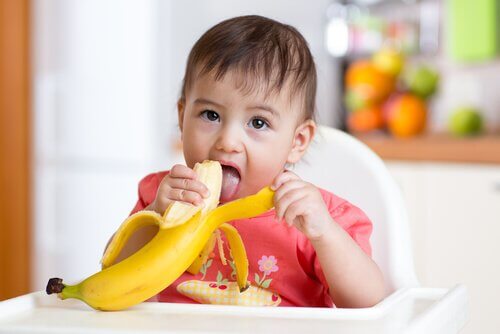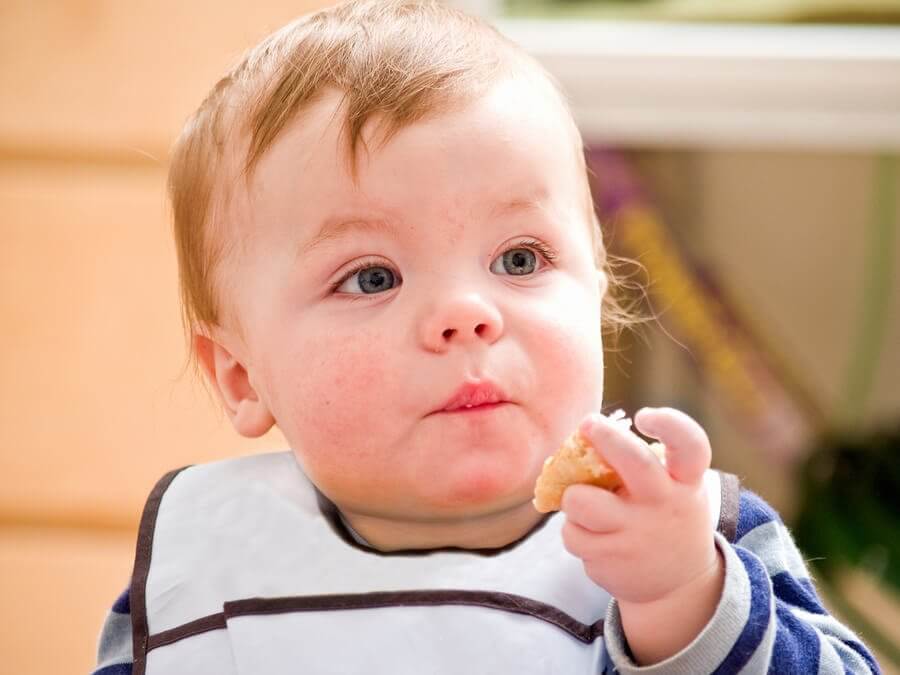Baby-Led Weaning: When and How to Start

Your children’s diet will always be a hot topic. Many techniques and methods have emerged over the years. Baby-led weaning is one of the most popular.
Baby-led weaning, also known as BLW, is a complementary feeding technique that incorporates solid foods into a baby’s diet. American nutritionist Gill Rapley developed this technique and shared her ideas in the book Helping Your Baby to Love Good Food.
BLW can be translated as “complementary self-regulated feeding.” With this technique, purées and porridges are removed from the baby’s diet. This is mostly a teaching method and not a feeding one that takes place until children turn one year old.
Through BLW, new food textures, smells, colors, and flavors are presented to babies without taking away the nutrients of breastfeeding. This means that babies will have the freedom to feed themselves in addition to exploring food through their senses.
By being able to eat with their hands, babies will develop eye-hand coordination and chewing skills. They’ll also discover likes and dislikes. This food learning process begins after 6 months of age. Before that period, WHO recommends exclusive breastfeeding.
When and how to apply baby-led weaning?
To start this technique, the following must be taken into consideration. Babies:
- Must be 6 months or older and completely healthy.
- Must be able to sit upright and stay in that position without help.
- Should be interested in solid food.
- Should know how to hold the food in their mouth without spitting it out.
If your baby demonstrates these skills, it’s time to start baby-led weaning. When doing so, include your baby at the table when eating as a family. By doing this, the baby will learn early by imitation, observing parents and family members.

Don’t worry about any possible disasters happening in the process. The most important thing is that your baby will learn to eat in natural way.
On the other hand, make sure your baby has a stable stance and his or her arms and hands have enough space to freely use them to eat. The baby should sit upright in front of a table, either in the baby seat, your lap, or a place where he or she will be comfortable.
Finally, don’t give the baby the food. Offer it so that he or she can decide to eat without any outside influences.
With baby-led weaning, purées and porridges are removed from the baby’s diet. This is mostly a teaching method, not a feeding one, that takes place until the child turns one.
How to start baby-led weaning?
You should start with foods that your baby can grab easily. For example, cut chicken into strips and gradually add new shapes. Offer soft foods in large pieces that the baby can suck or chew. You can also crush the food.
It’s important to offer one food at a time to observe possible allergic reactions and become familiar with your baby’s metabolism. Only your baby knows how much he or she wants to the point of satisfaction, so don’t worry about the portions.
Again, you shouldn’t stop giving your baby milk, since that is their main source of nutrients until the age of one. When your baby no longer wants to eat complementary foods, breastfeeding will provide the necessary nutrients.
Remember that this should be a fun time for babies. At first they’ll eat very little and will only play with the food and experiment with new flavors. Although iron deficiency isn’t common, give your baby iron-rich foods as a precaution.

What you shouldn’t feed your baby
You can offer your baby a variety of healthy foods, but there are some foods and supplements that babies shouldn’t eat. For example:
- Salt, honey and sugar, since babies’ kidneys are too small to assimilate them
- Green leafy vegetables, such as chards and spinach. They contain high levels of nitrates and aren’t recommended for children under one year old.
- Prepared meals, rice drinks, seaweed, seafood and large fish. These don’t provide optimum nutritional values for your baby’s development.
If you don’t want your baby to develop any food allergies to a particular food, let him or her rest for a few days and resume again. Avoid offering whole dry nuts due to the risk of choking and suffocation. The best thing to do is crush the nuts or make them into a purée.
Lastly, gradually adding new foods, and encouraging and motivating your baby with love and patience are key to the success of this technique. Baby-led weaning can become an art in its application, as everything depends on the creativity and imagination of each parent.
Your children’s diet will always be a hot topic. Many techniques and methods have emerged over the years. Baby-led weaning is one of the most popular.
Baby-led weaning, also known as BLW, is a complementary feeding technique that incorporates solid foods into a baby’s diet. American nutritionist Gill Rapley developed this technique and shared her ideas in the book Helping Your Baby to Love Good Food.
BLW can be translated as “complementary self-regulated feeding.” With this technique, purées and porridges are removed from the baby’s diet. This is mostly a teaching method and not a feeding one that takes place until children turn one year old.
Through BLW, new food textures, smells, colors, and flavors are presented to babies without taking away the nutrients of breastfeeding. This means that babies will have the freedom to feed themselves in addition to exploring food through their senses.
By being able to eat with their hands, babies will develop eye-hand coordination and chewing skills. They’ll also discover likes and dislikes. This food learning process begins after 6 months of age. Before that period, WHO recommends exclusive breastfeeding.
When and how to apply baby-led weaning?
To start this technique, the following must be taken into consideration. Babies:
- Must be 6 months or older and completely healthy.
- Must be able to sit upright and stay in that position without help.
- Should be interested in solid food.
- Should know how to hold the food in their mouth without spitting it out.
If your baby demonstrates these skills, it’s time to start baby-led weaning. When doing so, include your baby at the table when eating as a family. By doing this, the baby will learn early by imitation, observing parents and family members.

Don’t worry about any possible disasters happening in the process. The most important thing is that your baby will learn to eat in natural way.
On the other hand, make sure your baby has a stable stance and his or her arms and hands have enough space to freely use them to eat. The baby should sit upright in front of a table, either in the baby seat, your lap, or a place where he or she will be comfortable.
Finally, don’t give the baby the food. Offer it so that he or she can decide to eat without any outside influences.
With baby-led weaning, purées and porridges are removed from the baby’s diet. This is mostly a teaching method, not a feeding one, that takes place until the child turns one.
How to start baby-led weaning?
You should start with foods that your baby can grab easily. For example, cut chicken into strips and gradually add new shapes. Offer soft foods in large pieces that the baby can suck or chew. You can also crush the food.
It’s important to offer one food at a time to observe possible allergic reactions and become familiar with your baby’s metabolism. Only your baby knows how much he or she wants to the point of satisfaction, so don’t worry about the portions.
Again, you shouldn’t stop giving your baby milk, since that is their main source of nutrients until the age of one. When your baby no longer wants to eat complementary foods, breastfeeding will provide the necessary nutrients.
Remember that this should be a fun time for babies. At first they’ll eat very little and will only play with the food and experiment with new flavors. Although iron deficiency isn’t common, give your baby iron-rich foods as a precaution.

What you shouldn’t feed your baby
You can offer your baby a variety of healthy foods, but there are some foods and supplements that babies shouldn’t eat. For example:
- Salt, honey and sugar, since babies’ kidneys are too small to assimilate them
- Green leafy vegetables, such as chards and spinach. They contain high levels of nitrates and aren’t recommended for children under one year old.
- Prepared meals, rice drinks, seaweed, seafood and large fish. These don’t provide optimum nutritional values for your baby’s development.
If you don’t want your baby to develop any food allergies to a particular food, let him or her rest for a few days and resume again. Avoid offering whole dry nuts due to the risk of choking and suffocation. The best thing to do is crush the nuts or make them into a purée.
Lastly, gradually adding new foods, and encouraging and motivating your baby with love and patience are key to the success of this technique. Baby-led weaning can become an art in its application, as everything depends on the creativity and imagination of each parent.
All cited sources were thoroughly reviewed by our team to ensure their quality, reliability, currency, and validity. The bibliography of this article was considered reliable and of academic or scientific accuracy.
- Wikstrom S., Holst E., Infant botulism why honey should be avoided for children up to one year. Lakartidningen, 2017.
- D’Auria E., Bergaminni M., Staiano A:, Banderali G., et al., Baby led weaning: what a systematic review of the literature adds on. Ital J Perdiatr, 2018. 44 (1): 49.
This text is provided for informational purposes only and does not replace consultation with a professional. If in doubt, consult your specialist.








